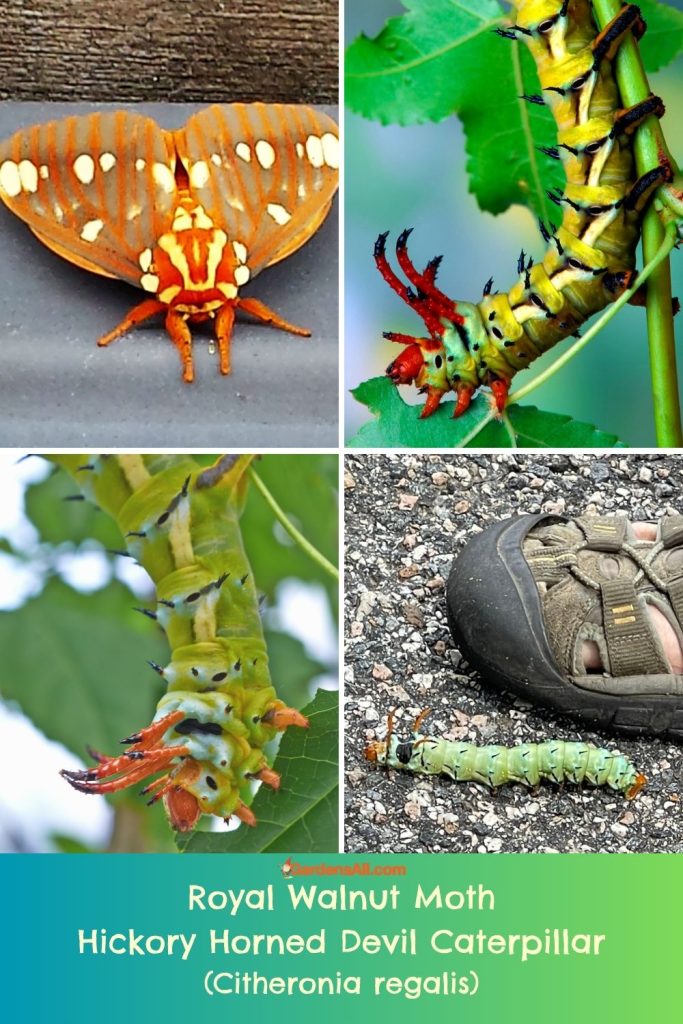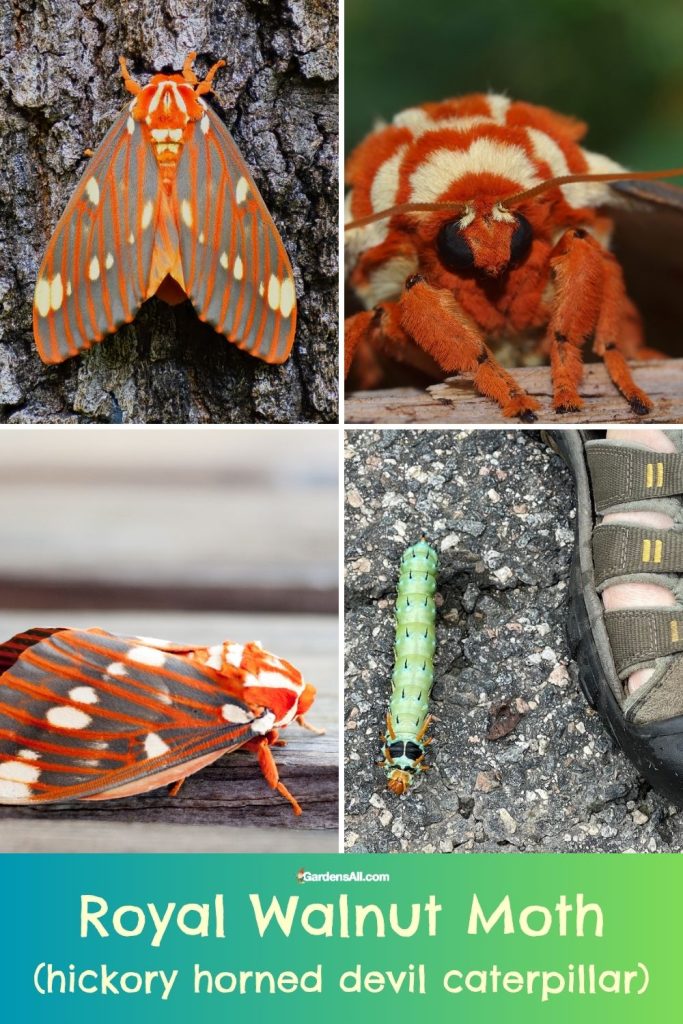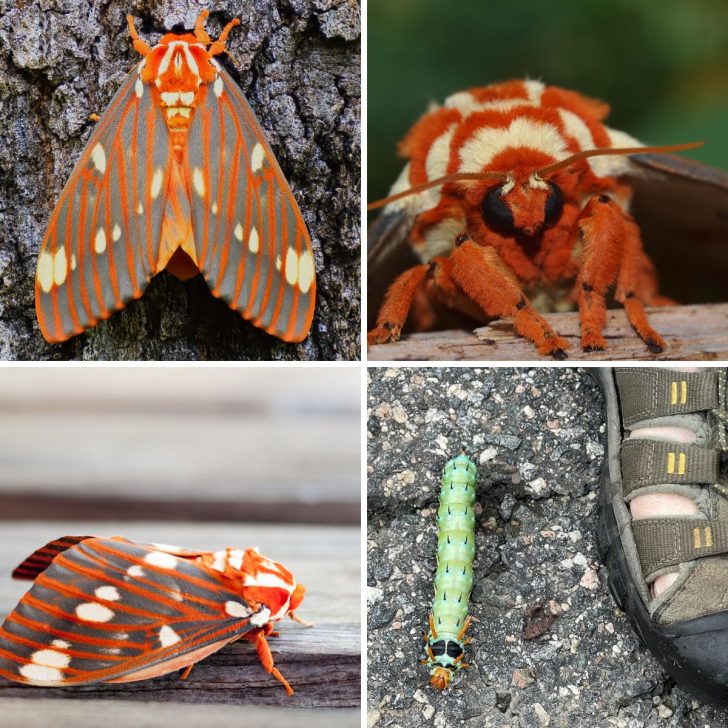Also known as the Regal Moth, the Royal Walnut Moth Caterpillar is the adult version of the Hickory Horned Devil Caterpillar, also touted as the Largest Caterpillar in North America.
We were on our daily dog walk when there upon the road was the largest and most beautiful caterpillar we’ve ever seen. It looked ominous with its spiky spine and multiple horns, so we didn’t want to touch it before knowing what kind of creature we’re dealing with.
One of the most painful stings I’ve ever had came from some caterpillar hiding on the underside of a Janet Craig plant leaves. There unseen and still with an unknown identity, it delivered a scream-worthy sting that lasted for hours of intense pain.
We’ve lived in this small, heavily wooded subdivision for over 33 years and had never seen this type of caterpillar before. That’s one of the many wonderful things about nature. We could probably study it every day for a lifetime and still have more to learn! So… we went home and looked it up so we could learn and then share it with you!
The Royal Walnut Moth Caterpillar: A Glimpse into the World of Citheronia Regalis
The Lepidopteran world is full of fascinating and diverse species. One of the most intriguing among them is the royal walnut moth caterpillar, scientifically known as Citheronia regalis. This remarkable caterpillar eventually transforms into the majestic royal walnut moth, catching the eye of observers and researchers alike. Here’s a closer look at this creature.
Taxonomy of the Royal Walnut Moth (and its caterpillar)
- Kingdom: Animalia
- Phylum: Arthropoda
- Class: Insecta
- Order: Lepidoptera
- Family: Saturniidae
- Genus: Citheronia
- Species: Citheronia regalis
- Genus: Citheronia
- Family: Saturniidae
- Order: Lepidoptera
- Class: Insecta
- Phylum: Arthropoda
Common Names for the Citheronia regalis
While the most popular names are “Royal Walnut Moth” for the adult and “Hickory Horned Devil” for the caterpillar, regional variations and local colloquial names might exist. The provided names are the most widely recognized and used in literature.
Adult Citheronia regalis Moth Common Names:
- Royal Walnut Moth
- Regal Moth
Caterpillar Citheronia regalis Common Names:
- Hickory Horned Devil
- Regal Moth Caterpillar
Appearance
Royal Walnut Moth
The adult moth is an impressive sight with a wingspan reaching up to 6 inches. Its wings display rich, earthy hues with a blend of oranges, browns, and yellows, making it a stunning sight in the wild.

Hickory Horned Devil (Larvae)
The caterpillar is equally magnificent and known for its bright green body, which can reach lengths of up to 5.5 inches. It is adorned with nine black-tipped, orange-red horns on its back, giving it its common name and making it one of the most intimidating-looking caterpillars in North America.
In late summer, before the Hickory Horned Devil pupates, (goes into its pupate state its color changes. This largest caterpillar in North America morphs from its characteristic bright green hue to beautiful shades of blue-green and turquoise.
This color change signifies that the caterpillar is ready to pupate. It then burrows into the ground to form its underground pupal chamber where it will remain until emerging as an adult moth.

Habitat & Range
The Citheronia regalis is native to the eastern United States, extending from Florida to New York, and west to Texas and Missouri. They predominantly inhabit deciduous forests, particularly in areas with walnut and hickory trees, which serve as primary food sources for the caterpillars.
While the Royal Walnut Moth is relatively common within its range, its caterpillar, the Hickory Horned Devil, is less frequently seen by the average observer. This is primarily due to their behavior of feeding on the upper canopy of trees, especially during their larger, later developmental stages. This arboreal habit keeps them hidden from the casual eye, often leading to misconceptions about their rarity.
Diet
Caterpillars, or the Hickory Horned Devils, primarily feed on the leaves of walnut, hickory, persimmon, and sumac trees. The consumption of leaves provides them with the necessary nutrients to undergo metamorphosis and turn into the royal walnut moth.
Sting & Toxicity
Despite its fierce appearance, the Hickory Horned Devil is harmless and does not have a venomous sting. Its intimidating horns and coloration are merely a defense mechanism to deter predators.
Conservation Status
The Royal Walnut Moth is relatively common within its range, and there are no immediate conservation concerns related to its population.

See also our popular article on the hummingbird moth caterpillar and learn the difference between this and the tomato hornworm caterpillar.
Conclusion
The Citheronia regalis species, both in its larval and adult form, is a testament to the beauty and diversity found within the world of insects. The Hickory Horned Devil, despite its formidable appearance, is a harmless caterpillar. We helped ours across the street so that it wouldn’t be crushed by a car or scooped up by a bird.
I’m LeAura Alderson, a garden, herb and plant enthusiast with a passion for discovering the many edible and medicinal benefits of the plants all around us, including the weeds! I’m a writer, editor and media publisher for our family of websites.
While I was certified in fitness and life coaching, I am NOT a health practitioner. However, I’m a lifelong health enthusiast, with a keen interest in healthy, organic foods and making home remedies and the content we share is from our own experience and usage as well as that extracted from scientific research so that you can explore further on your own.
Always seek the advice and guidance of your health practitioners first and foremost.
As a family we’re steadily expanding our gardening, experimentation and knowledge around all things gardening, edible landscaping, fresh organic foods and self sustainability with farming in our future. I also own and manage iCreateDaily.com, a site all about transformation through creation, and the power of positivity, optimism and mindset.

